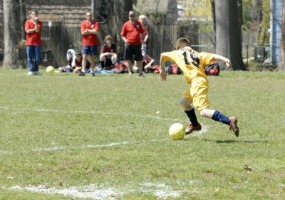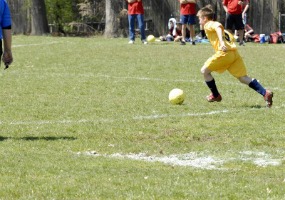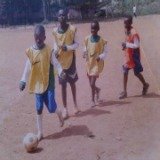Home | What's New | Free
Youth Soccer Speed Training
How to Beat your Opponents
Youth soccer speed training makes a difference between the best and average players. It is a powerful tool to beat your opponents. It requires quickness of thoughts and acts. Work on it during your soccer training.
As a former midfielder, my soccer style was based on speed and endurance. Connecting both defense and attack required me to run fast and all the time.
Youth soccer speed training is not just simple run in the pitch. It involves key elements.Young soccer players should work on it during practices.
Keys Elements of Youth Soccer Speed Training
A soccer player runs an average of 10 kilometers per game. As the pace increases, he needs a good speed to keep up. The following keys can help any player.
Quickness of thought. Think quickly and act faster. Like a driver behind the wheel, a player in the field has just “few seconds to think”. Quick thinking leads to great soccer speed.
Acceleration… with or without a ball. It is about reading the game first: opponent position, ball speed and path, your own position. It includes fast sprints in short distance.
Acceleration will help you to beat your opponents.
I remembered a strong opponent midfielder. Mbakop was his name. I can’t forget his running feet fanning the wind in front of me. His soccer speed was unstoppable. I had to work on mine to mach him up during each game.
Deceleration… includes a stop and change of direction. A good player knows exactly when to stop after speeding. The next move is a change of direction. Flexibility and balance come to play here.
Speed of thought, acceleration, deceleration, and change of direction are main keys to soccer speed. You learn to master them during training. You can do it alone or with your coach and team.
Developing your Youth Soccer Speed Training
Training should focus on acceleration. Soccer is a full body sport. Your speed consists of feet, body, and arms movements. Use strength feet workouts to develop your speed.
Agility of feet allows high soccer speed. I used a mixture of exercises to build my feet strength. Jumping with a rope, running up the hill, jogging all the time, working on a treadmill are just few of them.
Remember: feet strength gives you the best acceleration in the pitch. You can use it for different soccer training types.
If you accelerate, you will decelerate too. It means to stop first, and then change direction. Work out these two movements to decelerate. How do you go about it?
Use your creativity to build a routine of deceleration moves. Run forward 5 yards. Run backward 2 yards. Turn right, then left making an “S”. Follow with a Jump simulating heading. Create an angle stop which allows you to change direction.
Repeat this routine with and without a ball. Create similar routines which imitate your moves during a soccer game. The more you work on your routine, the better your deceleration will be.
Remember: deceleration goes with your own soccer style.
Change of direction comes after deceleration. It allows you to reposition yourself in the field. Creating that turn requires flexibility, balance and body positioning.
Different exercises help building a change of direction. Use your critical and speed thinking. Create rare tricky pirouettes, twirls, spins, and bending moves.
My personal method was working with alphabetic letters. I used to run back and forth, left and right, using letters like “W”, “Z”, “V”, “Y”. This is a secret effective and powerful method to work deceleration and change of direction.
Until present, I never came across a coach using this method. Try for yourself; you will be amazed by your results.
Should you use youth soccer speed training drills? Yes, with your team under coach supervision. From my soccer experience, drills will help, but you need to mix them with your own routine.
Youth soccer speed involves your critical and speed thought in the field. Create your own routine. Work them regularly. You will reach efficiently your best soccer speed.
Youth Soccer Speed training and Breathing Recovery
During a game, the more you speed up, the faster you go out of breath. Have you seen players bending with both arms on their knees? They are out of breath after speeding.
Most youth soccer speed trainings don’t evoke this aspect. From my experience, controlling your breathing is crucial to your speed. I used personal and small tricks to keep up my speed during games.
When you change direction and pass the ball to a teammate, I recommend you not to stop in one place. Keep moving or walking around. It balances your breathing.
Stopping in one area blocks your breathing. Your heartbeat becomes strong and you need either bend or sit down. This is one of the reasons players throw out lot saliva during the game.
After speeding, avoid breathing with opened mouth. It takes longer to recover. You will look and be tired. It is red sign that you can’t go further in the game.
The solution is to take several deep breaths with close mouth. Blow out air through your nose. Try to keep you chest straight to inhale and breath out lot of air.
Avoid bending or talking after speeding in the pitch. It takes away your strength. You waste lot energy while running, talking, and yelling in the field. Be as calm and cool as possible.
I used these tricks over and over during my soccer career and they work. Practice them over and over. You will execute them easily during soccer game.
Key components of soccer speed are: speed thought, acceleration, deceleration, change of direction, and safe breathing. Feet strength, agility, flexibility, balance, positioning, stamina should be part of your soccer breathing training.
You are invited to visit the home page of Youth Soccer
FREE Report!
Because you need to know how to get discovered and advance your soccer... please accept this FREE gift as my thank you for signing up below.
Best,
Val
Your Host
Hi, I'm Valentin Bikibili. Your Host on All-youth-soccer-training.com
Learn About Me...













New! Comments
Have your say about what you just read! Leave me a comment in the box below.